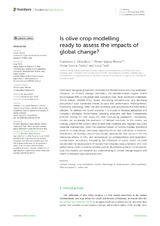Mostrar el registro sencillo del ítem
Is olive crop modelling ready to assess the impacts of global change?
| dc.contributor.author | Villalobos, Francisco J. | |
| dc.contributor.author | López Bernal, Álvaro | |
| dc.contributor.author | García Tejera, Omar | |
| dc.contributor.author | Testi, Luca | |
| dc.date.accessioned | 2024-04-10T09:40:05Z | |
| dc.date.available | 2024-04-10T09:40:05Z | |
| dc.date.issued | 2023 | |
| dc.identifier.uri | http://hdl.handle.net/10396/27857 | |
| dc.description.abstract | Olive trees, alongside grapevines, dominate the Mediterranean tree crop landscape. However, as climate change intensifies, the Mediterranean region, which encompasses 95% of the global olive cultivation area, faces significant challenges. Rising carbon dioxide (CO2) levels, increasing temperatures, and declining precipitation pose substantial threats to olive tree performance. Photosynthesis, respiration, phenology, water use and ultimately yield are possibly the main factors affected. To address this future scenario, it is crucial to develop adaptation and mitigation strategies. Nevertheless, breeding programs and field management practice testing for tree crops are time-consuming endeavors. Fortunately, models can accelerate the evaluation of tailored solutions. In this review, we critically examine the current state of olive tree modeling and highlight key areas requiring improvement. Given the expected impact of climate change, prioritizing research on phenology, particularly regarding bloom and pollination, is essential. Simulations of biomass should incorporate approaches that account for the interactive effects of CO2 and temperature on photosynthesis and respiration. Furthermore, accurately simulating the influence of water stress on yield necessitates the development of models that integrate canopy behavior with root performance under conditions of water scarcity. By addressing these critical aspects, olive tree models can enhance our understanding of climate change impacts and inform sustainable agricultural practices. | es_ES |
| dc.format.mimetype | application/pdf | es_ES |
| dc.language.iso | eng | es_ES |
| dc.publisher | Frontiers | es_ES |
| dc.rights | https://creativecommons.org/licenses/by-nc-nd/4.0/ | es_ES |
| dc.source | Villalobos, F. J., López-Bernal, Á., García-Tejera, O., & Testi, L. (2023). Is olive crop modelling ready to assess the impacts of global change? Frontiers In Plant Science, 14. https://doi.org/10.3389/fpls.2023.1249793 | es_ES |
| dc.subject | Climate change | es_ES |
| dc.subject | Crop simulation model | es_ES |
| dc.subject | Phenological development | es_ES |
| dc.subject | Photosynthesis | es_ES |
| dc.subject | Olea europaea L. | es_ES |
| dc.subject | Water use | es_ES |
| dc.title | Is olive crop modelling ready to assess the impacts of global change? | es_ES |
| dc.type | info:eu-repo/semantics/article | es_ES |
| dc.relation.publisherversion | https://doi.org/10.3389/fpls.2023.1249793 | es_ES |
| dc.relation.projectID | Gobierno de España. MCIN/AEI/10.13039/501100011033 | es_ES |
| dc.relation.projectID | Gobierno de España. TED2021-132217A-I00 | es_ES |
| dc.relation.projectID | Gobierno de España. PID2019-110575RB-I00 | es_ES |
| dc.relation.projectID | Gobierno de España. CEX2019-000968-M | es_ES |
| dc.relation.projectID | Junta de Andalucía. POSTDOC-21-00381 | es_ES |
| dc.relation.projectID | Gobierno de España. 2021/86493 | es_ES |
| dc.rights.accessRights | info:eu-repo/semantics/openAccess | es_ES |

